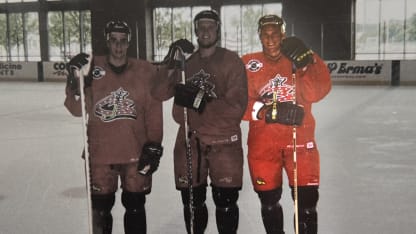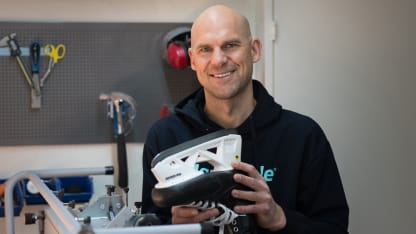Matthews of Maple Leafs touts innovative in-line skates, helps design own
Center among growing number of NHL players using them for offseason training

"It's something I picked up more recently; I didn't [in-line skate] much when I was younger," the Toronto Maple Leafs center told NHL.com.
Quite simply, Matthews did not like the feel of conventional in-line skates. It wasn't until the summer of 2018, when he discovered the version made by Marsblade, that he really took to in-line skating during the offseason where he resides in Scottsdale, Arizona, his hometown.
As soon as he tried the skates out, the difference from a conventional in-line skate stood out.
"Traditional roller hockey skates are flat," Matthews said. "Marsblades just have a different feel. With the 'Flow Motion Technology' and the rocker with how they work it's a pretty seamless transition (from ice skates). I thought they felt pretty similar to my ice skate. They feel more like ice skates than they do roller skates."
For Matthews and many other players around the NHL, Marsblade in-line skates are a game changer for offseason training.
"They are great for training and switching things up during the offseason when I'm not on the ice," Matthews said. "I love being outside and just blading around whether that's with my dog Felix or just going around the neighborhood."
Soon after discovering Marsblade skates, Matthews began to see more potential in the company than just a product he enjoyed. His agents Judd Moldaver and Rachel Feucht of Wasserman Hockey helped to negotiate an agreement that led to Matthews becoming an investor in Marsblade. It was the uniqueness of the product, its possibilities and the technology that attracted him to the company.
Marsblade recently introduced a custom collaboration with Matthews on a chassis -- the AM34 signature edition, which has allowed him to put his own touch on a line of roller skates.
"It was a lot of fun and something I knew I wanted to do," Matthews said. "I got to put my own touch on things, from the color to the personalized seal and design on the wheels. I love how they turned out."
He is hoping Marsblade can also serve as an entry point to hockey for people who have not grown up around the game.
"The more exposure people have to hockey the more the game will grow," Matthews said. "Especially in nontraditional markets."
\\\\
Founded in 2011, Marsblade has almost as unique of an origin story as Matthews, a kid from Scottsdale who become one of the best players in the NHL; he is the reigning Rocket Richard Trophy (leading goal-scorer with 60) and Hart Trophy (most valuable player) winner.

The founder and inventor behind Marsblade is 40-year-old Per Mars. He did not grow up studying to become an engineer. Before embarking on a journey to revolutionize in-line skates and then ice skate technology, he was a young hockey player growing up in Ostersund, Sweden, a small town of about 30,000 people. And he was good, a player everyone in town knew about.
"Per is four years older than me so he was always in the same minor hockey organization that I was," Los Angeles Kings defenseman Alexander Edler said. "He was always someone we were looking up to, especially once he got drafted. His mom was always helping out with the hockey program that they have in our town. He and his family, they've always been pretty well known in our town."
Mars worked his way up to the Sweden national team, representing his country in an under-19 tournament. The forward was selected by the Columbus Blue Jackets in the third round (No. 87) of the 2001 NHL Draft and looked to be on a path to the League.
"Very few people had seen him play in his draft year," said Doug MacLean, then the Blue Jackets general manager. "Our scouting staff was really intrigued because he was a great skater and had great size (6-foot-3, 205 pounds) but not a lot of experience. Our scouts wanted to take him in the third round, thought it was a bit of a flyer because they were intrigued with his skill set."
But a back injury slowed his playing career and ultimately cut it short. Though his dream of making his mark on the game as a player never came to fruition, the experience he gained while recovering from the injury led Mars on a path that is letting him have an impact on hockey in a way he never expected.
"I started stability and balance training when I was in the [United States Hockey League] with Lincoln (in 2002-03)," Mars said. "A year later I hurt my back pretty bad and played one season with a really bad back. After the injury is when I started really realizing the importance of balance training, and that's when I started thinking about ways to improve it and real early ideas of the product started to take shape. I realized if I should focus more on balance training, it would be much better to do it while actually skating rather than just standing on these balance balls."
Like Matthews before he discovered Marsblade, Mars never liked the feel of conventional in-line skates. He said he felt they not only didn't improve his ice skating, it actually got worse.
"It sort of cheats you to use the rolling skating technique because you can be lazy and it gives you too much stability," Mars said. "When you use regular rollers and go back on the ice, I felt all off balance because now it's more challenging skating on ice skates because it's more unstable with the blade. So that's why a lot of skating coaches have banned them and tell their guys you can't use regular [in-line skates] because it is going to wreck your stride. But now a lot of the same coaches are encouraging their guys to use our rollers because they see it actually helps them."
Brodie Tutton owns a power skating business and works directly with the Detroit Red Wings and Florida Panthers. He said Marsblade roller skates have allowed him to establish in-line skating as part of his training program for his clients.
"I love rollers a lot," Tutton said. "The skating and drills that I could show and get my players to do, you wouldn't be able to do in a regular pair of [in-line skates]. That's what I love most, is that on-ice feel."
\\\\
The genesis of the idea lived in Mars' mind for a few years while his playing career wound down. In 2008, Marsblade started to come to life when he was able to produce a few prototypes.
"I came up with the idea of implementing the instability between the wheels and the boot to improve my balance training while skating," Mars said. "Testing the first prototypes, the motion felt very similar to ice skating. … I was noticing really fast that this was something with a really unique feel and something that a lot of hockey players would enjoy."

Essentially, instead of having the boot attached directly to the chassis that holds the wheels, Mars has implemented an adjustable rocker that allows the boot to move back and forth on the chassis at customizable increments, mimicking the instability of a blade on ice.
And with that, Mars' patented Flow Motion Technology was born. He started trying to get the product in the hands of established NHL players, seeking their feedback. Among the early users was defenseman Anton Stralman, now with the Boston Bruins.
"I've been on a journey with Marsblade for probably a decade or so," Stralman said. "As a kid I skated a lot with [in-line skates], but I could tell this was something different with Per's. It represented and resembled more ice skating than any other [in-line skates] I had been on. A little more rocky, a little more ice skate feel to it. You can never copy it completely, but in terms of working out and getting as close to skating on the ice, that's the best you can get."
Like Matthews, Stralman believed in Mars' vision for the technology and became an early investor.
"It's something I feel I have a good understanding and knowledge about," Stralman said. "Most other investments are something that you don't really -- I mean I'm not a financial guy whatsoever, so I don't really get involved in a lot of investments -- but this is something I felt like would be fun to be a part of. It's a product you can actually physically feel and try and get a sense of."
\\\\
When the COVID-19 pandemic struck in the early part of 2020, it led to the shuttering of arenas across North America and a pause in the NHL season. With players looking for ways to continue training during the time off, Marsblade roller skates, because of how similar they felt to skating on ice, really started taking off.
After Tutton tried the roller skates himself and was thrilled with their performance, he reached out to Mars for help.
"I tried them out and loved the rollers," Tutton said. "As soon as that happened, I got 15 or 16 of the Red Wings going, Per reached out to them and got them set up. I was able to make up an off-ice roller skating instruction with different exercises and drills they could do off the ice to work on their skating and skills. The players all loved the rollers."
It was around that time that Gustav Nyquist, formerly of the Red Wings and now with the Blue Jackets, gave them a try as well.
"I use the rollers a lot. A lot of guys in the NHL use the roller skates now," Nyquist said. "If you compare to your standard [in-line skate], it's night and day how much more similar it is to skating. You're never going to get to a full similarity but it's pretty incredible for how well it works. [Conventional in-line skates compared to ice skates], it's a way different stride. It's pretty incredible what Per's come up with."
\\\\
Mars knows that getting a current player like Matthews involved in the company and using the in-line skate speaks to the belief in his technology that is starting to spread throughout the NHL.
"There has to be a lot of trust, and I think we checked a lot of boxes, of course with the product being the No. 1, but with the people we have involved with our company was a big factor," Mars said.
When he started the company, Mars' ultimate goal was to one day have former Vancouver Canucks players Daniel and Henrik Sedin try his product and endorse it. It's safe to say Marsblade has far and away surpassed that humble dream; Mars said the company has provided hundreds of NHL players with the in-line skates.
MacLean said he ran into Mars several years after he began the company while he was holding a demonstration of his roller skates.
"He really impressed me as a young entrepreneur," MacLean said. "It was fairly well along at that point because he was selling them when I saw him. I thought it was pretty impressive. It was fun to see him in that way, to be quite honest."
Like any successful team, Marsblade is not a one-man show. In bringing his early idea to market, Mars has built a comprehensive group that he credits for the success that the company has achieved. Now he is excited about what the future holds.
"We have an incredible team across the line with a really strong engineering team, a product design team, and everyone is so dedicated and working so hard to see these products come to life," Mars said. "So I'm really fortunate to work with an amazing group of people. I'm not going to lie, it's been a bumpy road and a ton of challenges along the way. I'm glad I didn't know how hard it would be when I started. A lot of entrepreneurs say this, but if I would have seen all the challenges coming, I might not even have started.
"[Seeing players using our products] is pretty surreal, to be honest."

















